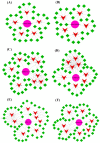Identification and Molecular Analysis of m6A-circRNAs from Cashmere Goat Reveal Their Integrated Regulatory Network and Putative Functions in Secondary Hair Follicle during Anagen Stage
- PMID: 35327094
- PMCID: PMC8944478
- DOI: 10.3390/ani12060694
Identification and Molecular Analysis of m6A-circRNAs from Cashmere Goat Reveal Their Integrated Regulatory Network and Putative Functions in Secondary Hair Follicle during Anagen Stage
Abstract
N6-methyladenosine (m6A) is the most abundant modification in linear RNA molecules. Over the last few years, interestingly, many circRNA molecules are also found to have extensive m6A modification sites with temporal and spatial specific expression patterns. To date, however, little information is available concerning the expression profiling and functional regulatory characteristics of m6A modified circRNAs (m6A-circRNAs) in secondary hair follicles (SHFs) of cashmere goats. In this study, a total of fifteen m6A-circRNAs were identified and characterized in the skin tissue of cashmere goats. Of these, six m6A-circRNAs were revealed to have significantly higher expression in skin at anagen compared with those at telogen. The constructed ceRNA network indicated a complicated regulatory relationship of the six anagen up-regulated m6A-circRNAs through miRNA mediated pathways. Several signaling pathways implicated in the physiological processes of hair follicles were enriched based on the potential regulatory genes of the six anagen up-regulated m6A-circRNAs, such as TGF-beta, axon guidance, ribosome, and stem cell pluripotency regulatory pathways, suggesting the analyzed m6A-circRNAs might be essentially involved in SHF development and cashmere growth in cashmere goats. Further, we showed that four m6A-circRNAs had highly similar expression trends to their host genes in SHFs of cashmere goats including m6A-circRNA-ZNF638, -TULP4, -DNAJB6, and -CAT. However, the expression patterns of two m6A-circRNAs (m6A-circRNA-STAM2 and -CAAP1) were inconsistent with the linear RNAs from their host genes in the SHFs of cashmere goats. These results provide novel information for eluci-dating the biological function and regulatory characteristics of the m6A-circRNAs in SHF development and cashmere growth in goats.
Keywords: M6A-circRNAs; cashmere goat; expression characterization; regulatory network; secondary hair follicle.
Conflict of interest statement
The authors declare no conflict of interest. The funders had no role in the design of the study; in the collection, analyses, or interpretation of data; in the writing of the manuscript, or in the decision to publish the results.
Figures







Similar articles
-
CircRNA-1967 participates in the differentiation of goat SHF-SCs into hair follicle lineage by sponging miR-93-3p to enhance LEF1 expression.Anim Biotechnol. 2023 Jun;34(3):482-494. doi: 10.1080/10495398.2021.1975729. Epub 2021 Sep 22. Anim Biotechnol. 2023. PMID: 34550847
-
MeRIP-seq data analysis and validation reveal the regulatory role of m6A modified circRNAs in the apoptosis of secondary hair follicle cells in Inner Mongolia cashmere goats.Comp Biochem Physiol Part D Genomics Proteomics. 2025 Jun;54:101419. doi: 10.1016/j.cbd.2025.101419. Epub 2025 Jan 12. Comp Biochem Physiol Part D Genomics Proteomics. 2025. PMID: 39837064
-
Expression Profiling and Functional Analysis of Circular RNAs in Inner Mongolian Cashmere Goat Hair Follicles.Front Genet. 2021 Jun 11;12:678825. doi: 10.3389/fgene.2021.678825. eCollection 2021. Front Genet. 2021. PMID: 34178035 Free PMC article.
-
N6-Methyladenosine (m6A)-Circular RNA Pappalysin 1 (circPAPPA) from Cashmere Goats: Identification, Regulatory Network and Expression Potentially Regulated by Methylation in Secondary Hair Follicles Within the First Intron of Its Host Gene.Animals (Basel). 2025 Feb 18;15(4):581. doi: 10.3390/ani15040581. Animals (Basel). 2025. PMID: 40003062 Free PMC article.
-
Melatonin's Role in Hair Follicle Growth and Development: A Cashmere Goat Perspective.Int J Mol Sci. 2025 Mar 21;26(7):2844. doi: 10.3390/ijms26072844. Int J Mol Sci. 2025. PMID: 40243438 Free PMC article. Review.
Cited by
-
N6-Methyladenosine modification (m6A) of circRNA-ZNF638 contributes to the induced activation of SHF stem cells through miR-361-5p/Wnt5a axis in cashmere goats.Anim Biosci. 2023 Apr;36(4):555-569. doi: 10.5713/ab.22.0211. Epub 2022 Nov 14. Anim Biosci. 2023. PMID: 36397699 Free PMC article.
-
Identification and functional analysis of m6A in the mammary gland tissues of dairy goats at the early and peak lactation stages.Front Cell Dev Biol. 2022 Oct 18;10:945202. doi: 10.3389/fcell.2022.945202. eCollection 2022. Front Cell Dev Biol. 2022. PMID: 36330333 Free PMC article.
-
Understanding Circular RNAs in Health, Welfare, and Productive Traits of Cattle, Goats, and Sheep.Animals (Basel). 2024 Feb 27;14(5):733. doi: 10.3390/ani14050733. Animals (Basel). 2024. PMID: 38473119 Free PMC article. Review.
-
Screening and expression validation of key proteins for secondary hair follicle growth in cashmere goats based on iTRAQ quantitative proteomics technology.Front Vet Sci. 2024 Oct 15;11:1441074. doi: 10.3389/fvets.2024.1441074. eCollection 2024. Front Vet Sci. 2024. PMID: 39474271 Free PMC article.
-
Genome-wide DNA methylation and transcriptome analyses reveal the key gene for wool type variation in sheep.J Anim Sci Biotechnol. 2023 Jul 8;14(1):88. doi: 10.1186/s40104-023-00893-6. J Anim Sci Biotechnol. 2023. PMID: 37420295 Free PMC article.
References
-
- Bai W.L., Zhao S.J., Wang Z.Y., Zhu Y.B., Dang Y.L., Cong Y.Y., Xue H.L., Wang W., Deng L., Guo D., et al. LncRNAs in Secondary Hair Follicle of Cashmere Goat: Identification, Expression, and Their Regulatory Network in Wnt Signaling Pathway. Anim. Biotechnol. 2018;29:199–211. doi: 10.1080/10495398.2017.1356731. - DOI - PubMed
-
- Kloren W.R.L., Norton B.W., Waters M.J. Fleece growth in Australian cashmere goats. III. The seasonal patterns of cashmere and hair growth, and association with growth hormone, prolactin and thyroxine in blood. Aust. J. Agric. Res. 1993;44:1035–1050. doi: 10.1071/AR9931035. - DOI
-
- Wu J.H., Zhang Y.J., Zhang J.X., Chang Z.L., Li J.Q., Yan Z.W., Husile, Zhang W.G. Hoxc13/β-catenin correlation with hair follicle activity in cashmere goat. J. Integr. Agric. 2012;11:1159–1166. doi: 10.1016/S2095-3119(12)60110-5. - DOI
Grants and funding
LinkOut - more resources
Full Text Sources
Miscellaneous

